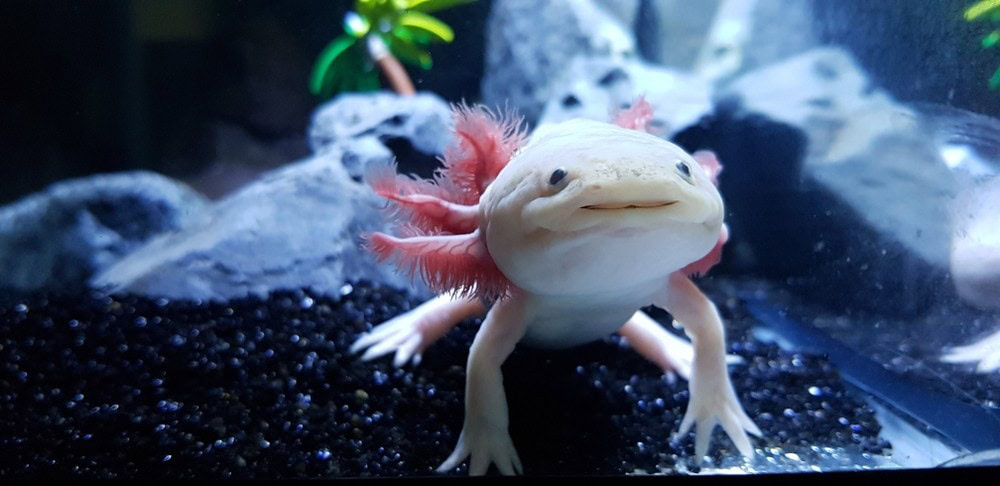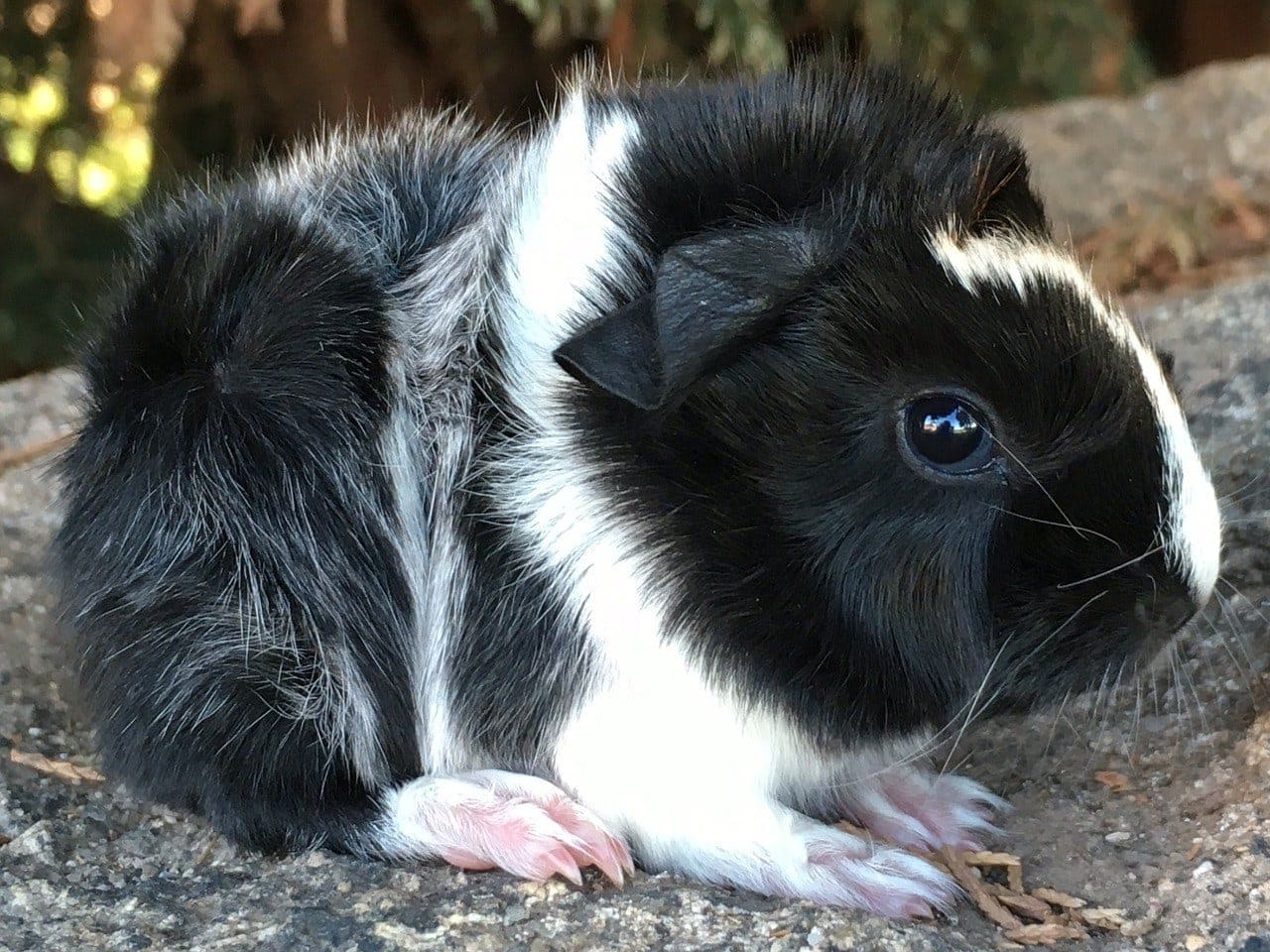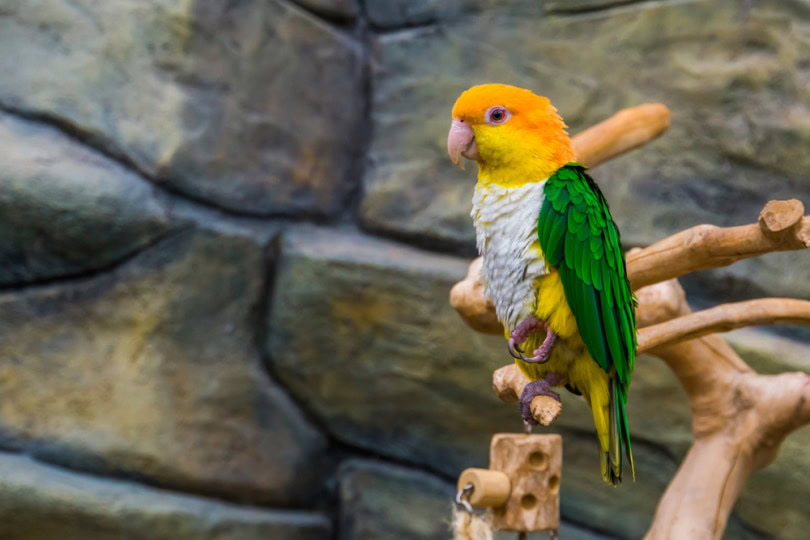Click to Skip Ahead
Axolotls are a unique salamander native to the lakes around Mexico City. Unlike other salamanders, they don’t “grow up” and live their lives underwater; they never emerge on land like their cousins.
Because of this, they can be kept in fish tanks and are one of the more popular salamanders. They are pretty easy to care for and are incredibly hardy. They can even be bred in captivity, which allows them to be purchased for relatively cheap. The temperature and water flow are the most critical factors determining whether they thrive in captivity, but these factors are simple for beginners to get right.

Quick Facts about the Axolotl
| Species Name | Ambystoma mexicanum |
| Family | Ambystomatidae |
| Care Level | Low |
| Temperature | 57°–68° Fahrenheit |
| Temperament | Bold |
| Color Form | Many |
| Lifespan | 20 years |
| Size | 12″ |
| Diet | Earthworms, bloodworms, and similar prey items |
| Minimum Tank Size | 15-gallon tank |
| Tank Set-Up | Hiding spots, large gravel, filter |
| Compatibility | None |
Axolotl Overview
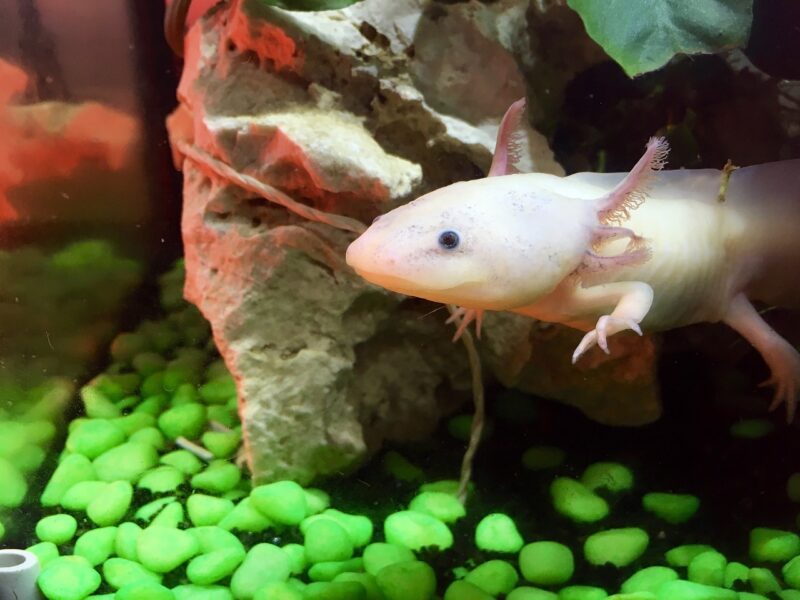
The axolotl is commonly called the “Walking Fish,” as it is an entirely aquatic species that develops legs and “walks.” However, it is not a fish at all. It’s a salamander that simply never leaves the water. Instead, it develops its legs and remains underwater even after reaching full development. It breeds underwater and spends its whole life there, which makes it unique in the salamander world. This salamander never undergoes a metamorphosis.
They are native to several lakes around Mexico City. Their small territory has caused them to become critically endangered, primarily due to people’s activities and city development. In 2010, they were near extinction due to the urbanization of Mexico City and the water pollution that came with it. Invasive species that preyed on the salamander also played a role.
The axolotl is sometimes confused with the waterdog, a similar salamander that occasionally spends its whole life in water. They also resemble mudpuppies, who spend their whole lives underwater but do not bear many resemblances to the axolotl.
Axolotls are commonly kept as pets, and their popularity increases each year. However, they are also extensively used in scientific research since they quickly grow back their limbs. They were once a staple in the Aztec diet and were once sold as food, though their rarity now makes that difficult and often illegal.
What Do Axolotls Cost?
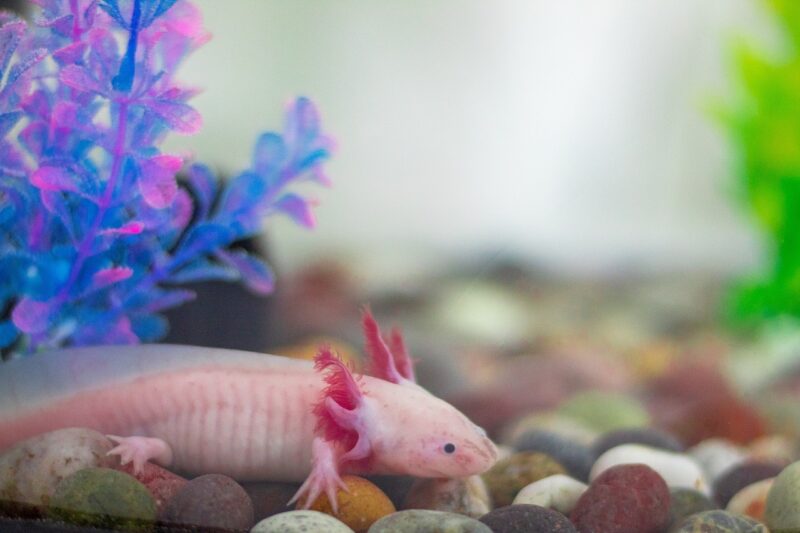
Axolotls are not expensive. You can expect to pay between $20 and $70. Unlike other exotic pet species, they can be easily bred in captivity. The best place to adopt them is from a local breeder. It is important not to purchase them online through classified ads and similar mediums, as many people who sell may not have the animal’s health in mind.
You should always research a seller before purchasing from them. Not only is this important for the health of your axolotl, but it is also essential not to fund sub-par breeders or those abusing the species to make a few dollars. Axolotls are relatively newer pets, so it isn’t odd for bulk breeders to produce sub-par animals to make money.
Ask the breeder about the animal’s origin, its parents’ health, and its health history. Ask to see the space where the axolotl is staying. The quality of the tank is often a good sign of the animal’s quality. However, you should be aware that some breeders may have a separate “show” tank where they keep animals they’re selling, though they may not have grown up in similar conditions.
Axolotls with rare colorings are more expensive than those with “normal” colorings. If you want an axolotl with a specific color, you should plan on spending a bit more money. Never purchase an axolotl without seeing it first. A healthy salamander will be active and may accept the food that it is offered. Because axolotls only eat until they are full, don’t assume an axolotl that doesn’t want to eat is unhealthy.
That is often a good test with fish, but not this salamander. The animal’s skin should not be flaky, indicating a health condition.
Typical Behavior and Temperament
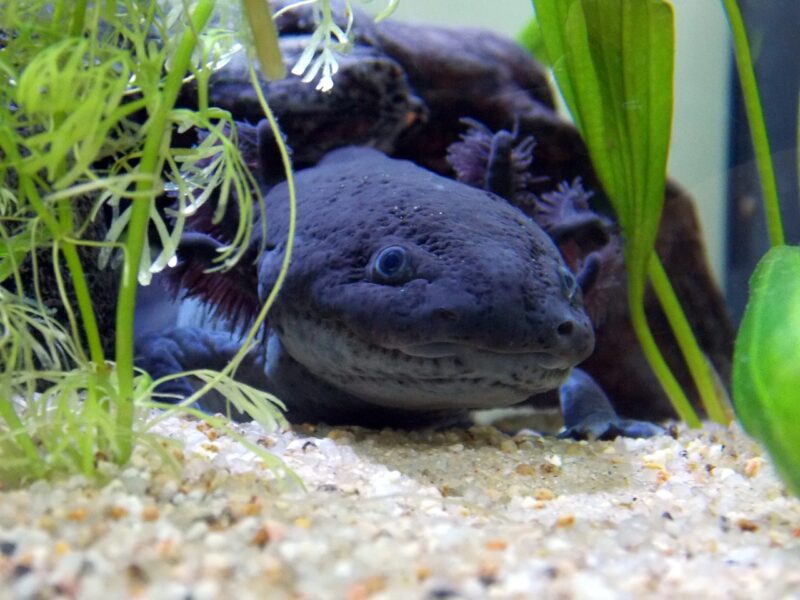
Axolotls are pretty hardy and can tolerate significant changes in their environment. They are somewhat adaptable and not nearly as sensitive as other fish. However, they are pretty squishy—literally. Much of their body is cartilage, not bone. They also have permeable skin that is susceptible to poor water conditions. Axolotls are sensitive to handling, so they shouldn’t be handled more than necessary.
Generally, they are simple to care for. They usually only need a few hours of work per week with the correct tank setup. Axolotls are fun animals to watch and are typically not shy. They don’t mind interacting with people through the glass and are pretty interactive even though they can’t be handled.
Axolotls have a unique ability to regenerate limbs. If something gets bitten off, it will grow back with time. However, that doesn’t necessarily mean you shouldn’t be cautious about injuries. They can still cause stress, which can lead to infections and diseases.
Appearance & Varieties
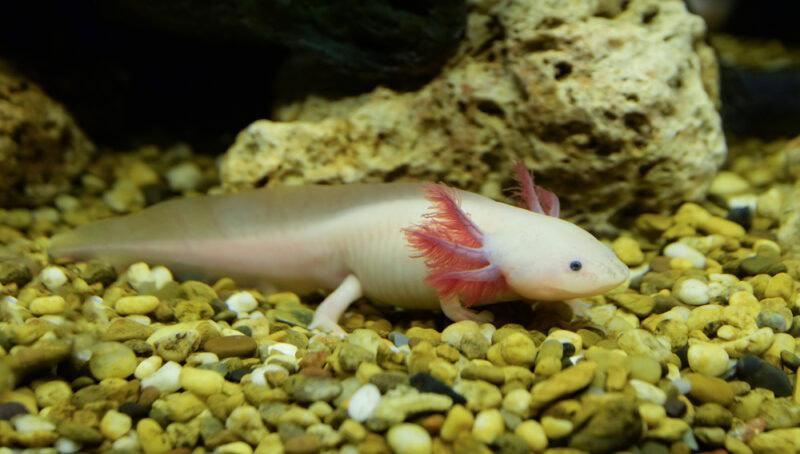
The axolotl comes in several colors. Most of the morphs are only found in captivity and were developed through selective breeding. In the wild, only the “wild” type exists. Here are some of the most common colorations:
- Wild Type: The usual coloration of browns, blacks, and greens. Speckles of gold are common.
- Leucistic: White body color with bright red gills. Most pet axolotls are leaning toward this color pattern as it is one of the most popular options.
- White Albino: White body, clear eyes, and bright red gills.
- Golden Albino: Similar to the white albino, but with a golden body. The gills are typically peach instead of red.
- Melanoid: There isn’t much that separates this color from the wild type. They are darker. They don’t have the shine or gold flecks throughout their body like other color types.
Some very rare colorations are challenging to find. They are often more expensive and may require extensive searching before you finally find one.
- GFP: These axolotls were genetically modified in a lab setting to glow vibrantly under UV light. Initially, this was for research purposes. However, they are now available as pets.
- Copper: One of the rarest color options. This is a variant of an albino axolotl. They have a light brown, freckled appearance and red-tinted eyes.
Some other variants exist, but they are practically unobtainable. They are developed for genetic research and other types of scientific investigation. Sometimes, a batch of axolotls may be one of a kind.

How to Take Care of an Axolotl
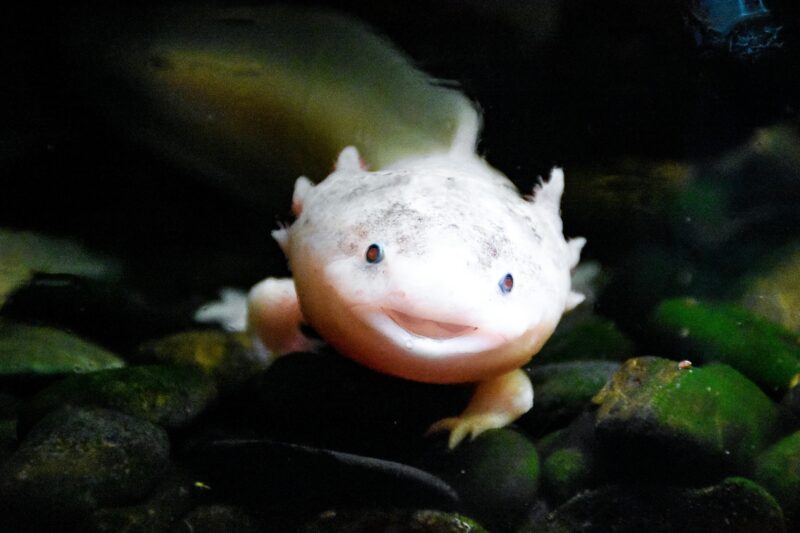
Habitat, Tank Conditions & Setup
You will need at least a 15- to 20-gallon fish tank for your axolotl. Generally, bigger is better, so we recommend choosing the 20-gallon, if possible. Larger tanks have less temperature and water quality fluctuations, which will keep your salamander healthier. The tank should be outfitted with a secure lid, as axolotls can jump out of their habitat.
This can spell disaster for axolotls, so it is best to prevent it entirely with a lid. The lid will also prevent dust and bugs from getting into the tank. Unlike other salamanders, you don’t need to set up a land area in your axolotl’s tank. They are entirely aquatic creatures and have no use for a land surface.
The depth of the water should be at least greater than the length of the axolotl. However, a deeper water level is preferred. This will provide your salamander with more room to move and prevent water quality issues.
Lighting
The tank should not be kept in direct sunlight, which can encourage algae to grow. No special lighting is required for these animals. You don’t need a light, which will solely help you view the animal.
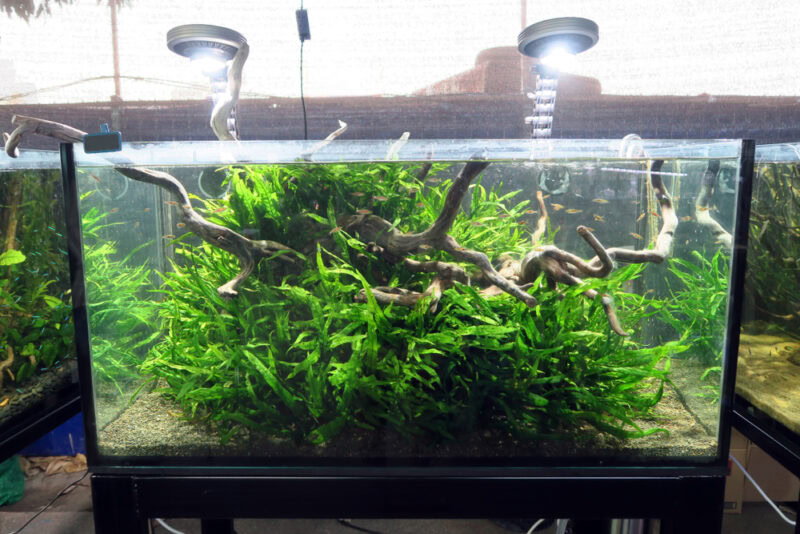
Temperature
The temperature should stay between 57 and 68 degrees Fahrenheit. In most cases, you will not need a heater to meet this requirement. Your bigger problem will often be keeping the water cool and preventing overheating. The water should not reach above 75 degrees, which is far too hot for an axolotl and can cause health problems. Water chillers can keep the water at this temperature if your area is warmer.
Hiding spots are recommended to help your pet feel a bit safer. There are many commercial hiding spots available, or you can use a DIY option like a flowerpot.
Water Conditions
A substrate is not required, and you may see many tanks without it. However, it can stress the axolotl if they cannot get a foothold on the bottom. You may want to add gravel to provide grip. It should be larger than the salamander’s head to prevent it from being eaten, which can cause impaction. You can also use terrarium sand, which the salamander is less likely to confuse as food.
Tap water is unsafe for axolotls, as it contains chlorine and chloramines that can harm and cause health problems. Instead, it must be treated before it is used to remove the dangerous chemicals. Distilled water is also not recommended. The pH of the water should be 6.5 to 7.5. A filter is recommended to maintain the water quality of the tank. You can choose not to use a filter, but the tank will require more water changes and work. Filters should have a very slow filtration rate, as these animals are not used to high flow rates. They live in lakes, after all.
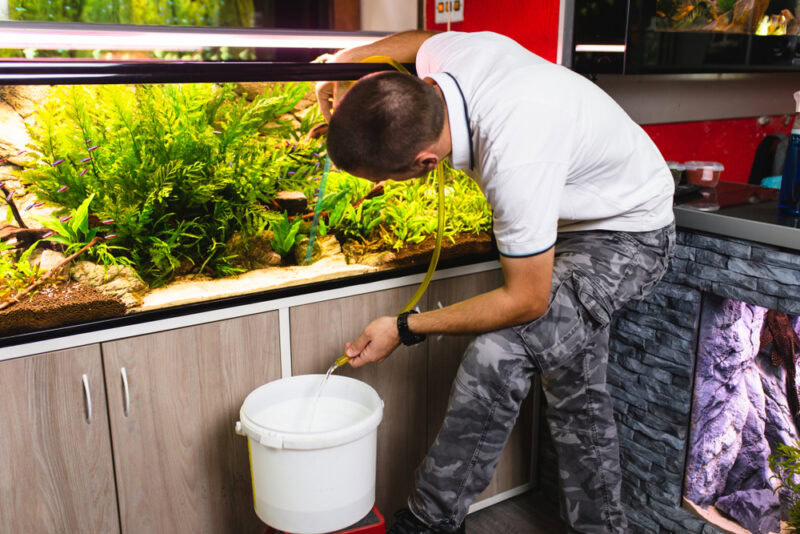
Water Quality
To maintain a filtered tank, change 20% of the water each week and clean the substrate with a siphon. This will remove waste that disrupts the water quality. Without a filter, you must do a 20% water change daily. Do not completely change the water; this will drastically alter the water chemistry and cause stress.

Do Axolotls Get Along With Other Pets?
Axolotls are not social animals. They do not enjoy tank mates and should be kept by themselves. They shouldn’t be kept with fish since they will eat them. The fish may also nip the axolotl. While this isn’t necessarily terrible, it can cause unnecessary stress. Axolotls are cannibalistic toward each other, especially when they are younger. For this reason, it is best to keep them in separate containers, even when they are still very young.
Sometimes, adults will get along fine together. However, it isn’t odd for them to suddenly turn cannibalistic again, even after years of living together.
What to Feed Your Axolotl
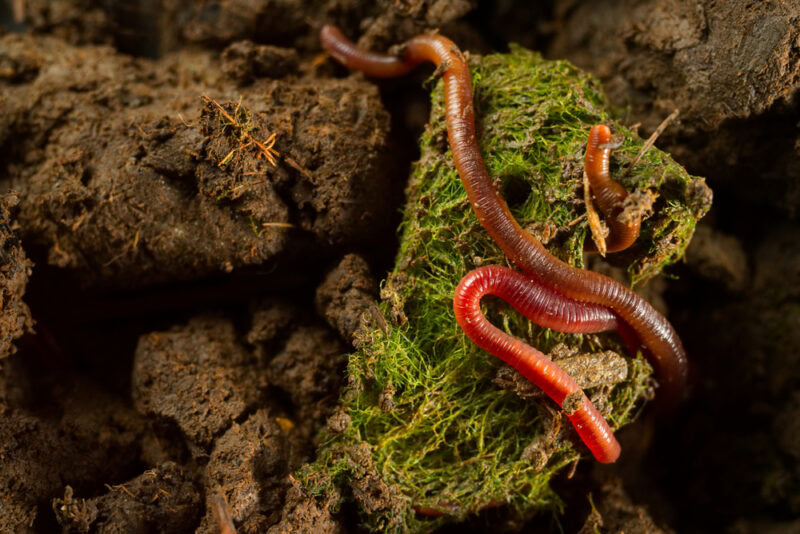
When in captivity, an axolotl can be fed a varied diet of shrimp, stripes of beef, bloodworms, earthworms, and other frozen prey items. The food is available at your local pet store in a freezer and is not as expensive as you would imagine.
You should not use worms intended for fishing since they may contain parasites. They are not kept to the same standards as worms for captive pets. Do not use worms that you catch yourself, either.
Axolotls do not need any supplements. If fed a varied diet, they typically receive everything they need from their food. Large earthworms are the most complete food for axolotls. However, other prey items can be used as well.
The easiest way to feed them is to hold the food in round-nosed forceps and move it near the axolotl. If they are hungry, they will typically eat it. Adults only eat two to three times a week, but younger axolotls eat more. They’re most active in the evenings, so many prefer to eat at this time. They don’t tend to overeat, so you usually don’t have to worry about them consuming too much food.
Remove all uneaten food from the tank to keep the water clean. It will begin to decay in the water, which will quickly reduce the water quality.
Keeping Your Axolotl Healthy
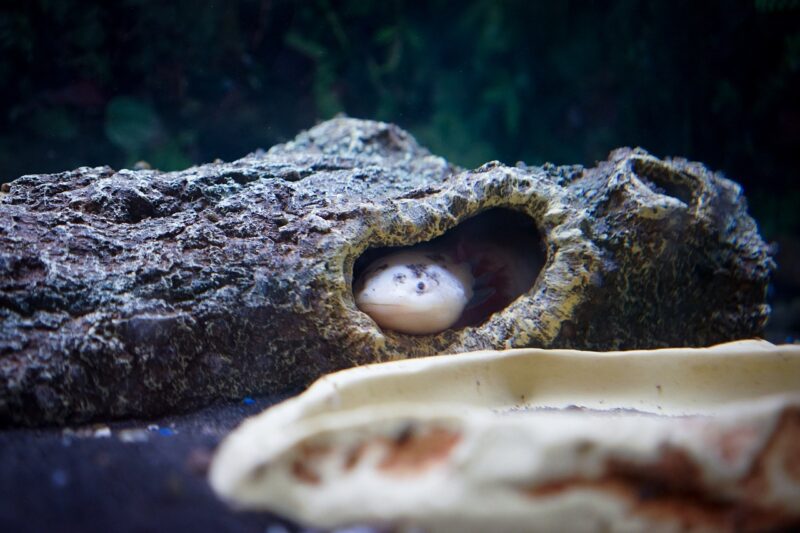
Axolotls are not sensitive to injuries and can regenerate their limbs. This is true for other body parts, such as their heart tissue. If the injury is not immediately life-threatening, they can regrow whatever was destroyed.
However, this superpower doesn’t mean that they are entirely healthy. They’re prone to bacterial infections and parasites. Unsanitary tank conditions often lead to bacterial infections, especially if the animal is stressed.
Ammonia buildup in the water can also be toxic, leading to gasping and inflammation. Ammonia burns their gills, eventually leading to death. Keeping the water quality good is essential to their well-being.
Gastrointestinal obstructions are common, as they are prone to eating inedible items. Luckily, they only have access to what you put in their tank. Therefore, don’t put anything smaller than their mouth in their tank. Gravel should be larger than the axolotl’s head so that it cannot be eaten.
Breeding
Breeding two axolotls requires keeping two adults in the same tank. They should both be adults to limit cannibalism, and the tank will need to be quite large. Axolotls lay eggs. Typically, the male will deposit his sperm sacks onto a flat surface, which the female will then collect. The fertilized eggs will be laid an hour or so later.
The tank should have plenty of space for the female to lay her eggs, and she should be generally unstressed. Otherwise, she will not mate.


Are Axolotls Suitable for You?
If you’re looking for an exotic but easy pet, an axolotl is ideal. These salamanders are unique in that they live underwater their whole lives. They’re hardy creatures that don’t require much care. If you set up their tank correctly with a filter, you’ll only need to change their water weekly and feed them two to three times a week as adults. This is far less care than other animals require, which can make them suitable options for those without much time on their hands.
Still, maintaining the water quality is essential for their health, as they are prone to bacterial infections. They may be able to regrow limbs, but that doesn’t mean they’re immortal. Keep an eye on the water quality, and your axolotl can live a very long life.
See also:
Featured Image Credit: Jeffrey Lagmay, Shutterstock
